Abstract
The publication deals with the problem of the effect of interference with the movement of the “preceding” train on the movement of the “following” train in the case of efforts to reduce the distance between trains on a moving block interval. The paper presents results of the simulations for train of the ED250 type for a set of 135 traffic situations: for three contexts of reducing the speed of the “preceding” train, for five variants of the method of controlling the “following” train and for nine initial distances between these trains. The results confirmed the possibility of gaining time and energy benefits by implementing an appropriate method of controlling the “following” train, as well as providing insights into the area of shortening the gaps between trains, including the pursuit of synchronizing the speed of trains and possibly coupling them into a so-called virtual couples.
1. Introduction
Background of the Issue
Modern railroad traffic control systems have not exhausted all possible improvements and optimizations from the point of view of increasing the capacity of the railroad line, improving the fluidity of train traffic, and minimizing losses of time and energy efficiency.
Based on the technical documentation, i.e., the system requirement specifications for ERTMS/ETCS [1], solutions are applied to fundamentally guarantee the safety of train traffic, including the establishment of the minimum permissible distances between trains.
ERTMS/ETCS Level 3 introduces the concept of operating trains with moving block distances, in which all trackside equipment is removed and trains are separated by an absolute braking distance. The movement of trains conducted according to the moving block distance [2] consists of determining the free path for the “following” train to the place of the last reporting of the identified end of the “preceding” train. On the basis of the dynamic speed profile, taking into account the train braking curve, the selection of the maximum permissible, at a given moment, speed of the “following” train is determined, taking into account the distances to the end of the free path [3].
However, such a speed profile of the “following” train is not necessarily the most advantageous from the perspective of travel time and energy consumption. In the event of an unforeseen disturbance to the “preceding” train, such as a brief reduction in speed, the preservation of the maximum speed by the “following” train may adversely affect the conservation of the train’s kinetic energy and thus the maintenance of the scheduled running time.
2. Related Work
Consideration of aspects of the benefits of appropriate train control of the “following” train is the subject of numerous studies and publications. It should be noted that these benefits are multidimensional.
The authors of the report [4,5] present the concept of virtual coupling as a solution to allow trains to congest the line and increase its capacity. This solution is also considered by the authors of [6], where requirements on tolerated latency associated with the channels used for train-to-trackside and train-to-train communications are indicated. Key parameters identified include the need to equalize the speed between trains and to establish the distance between them (the time needed for coupling). It was also pointed out that an important aspect of applying a technical solution is to carry out studies on the possible benefits of increasing train throughput and punctuality, taking into account the dynamics of moving trains and scenarios of disturbed operations.
The study in [7] also takes into account Virtual Coupling and analyzes the harmony between the rail transit periodic operation characteristics or system constraints and Virtual Coupling technology. It proposes a cooperative speed and distance adjustment strategy that satisfies the virtual coupling condition.
New technologies, such as Virtual Coupling, carry many risks that theoretical considerations may not show. Therefore, the authors of [8] point to the need to prepare appropriate test benches in laboratory conditions, which can identify problems in real systems.
An interesting study providing an overview of train speed profiling solutions for optimizing energy consumption is [9]. The authors indicate that the energy efficiency of running a single train can only be improved in terms of coasting, as previously studied in [10]. On the other hand, the authors of [11] point to traffic fluidity as one criterion that is relevant for the evaluation of the quality of rail transport services and directly translates into the energy efficiency of train running. Another possibility for increasing the energy efficiency of train running is reported in [12]. A strategy where the energy obtained by recuperation is immediately used by other trains is considered. The authors of [13] investigate the energy-efficient train timetabling and rolling stock circulation planning problem for metro lines based on flexible selections of train operation levels, which involve running levels (various running times and speed profiles) and dwell levels (various dwell times at stations). In [14], the focus is on a methodology for energy-efficient train operation involving Q-Learning-based driving profile shaping. The basic idea of the Energy Distribution Based Method (EDBM), which transforms the eco-driving problem into a finite Markovian decision process, is presented. The topics of the article [15] are outside the railway industry but deal with the study of the eco-driving problem for hybrid electric vehicles (PHEVs) to minimize the total cost of energy consumption, which seems to coincide with railway issues. In [16], the authors deal with a speed trajectory optimizer for a partial eco-driving optimization problem. Pontryagin’s maximum principle is used to derive the necessary conditions for the optimal solution. Further issues on eco-driving can be found in [17,18,19,20,21,22,23]. As is clear, these topics are popular, and new ideas for improving energy efficiency in this way are constantly emerging.
Currently, further automation and digitization of railway solutions is being pursued [24,25,26], allowing more information to be transmitted [27] and processed into key information for more optimal train control.
In the late 1990s, Transrail started a research project to develop a C-DAS system, the first large-scale tests of which, called Computer-Aided Train Operation (Cato), were carried out with mining operator LKAB on heavy haulage lines in northern Sweden in 2010; Transrail launched the technology in 2015.
Cato-Train calculates the optimum speed profile required for a train to reach its destination, within a specified time, based on the train’s traction characteristics, timetable and the driver’s adherence to previously given recommendations.
The optimal speed profile, displayed as a pointer on the traction vehicle driver’s dashboard (DMI), can be determined based on five advisory strategies:
- application of the minimum braking,
- application of the “experienced driver” profile,
- keeping a constant minimum speed to a target with a specified driving time,
- keeping a constant speed and driving without the application of propulsion to a target with a specific driving time,
- optimal speed profile, taking into account track profile, speed limits and time to destination.
Publication [28] collates information on the driver assistance systems used, including variants of the system architecture. Variants of locating the data processing unit on the train or in the Traffic Control Centre (TCC) are considered.
The basis for determining the optimal speed profile is the following data: geography of the network and location of the time points (timetable), gradients of the track gradients, permissible train running speed, train characteristics including traction and resistance characteristics of a given train set, semaphore indications, location and speed of a given train.
In the case of a system located in a TCC, there is a possibility of detecting traffic conflicts and calculating new target train running times to avoid these conflicts.
This paper is a continuation of the authors’ work [29] on the issue of energy efficiency and train smoothness on a railway line with fixed block distance. In this publication, the conclusions of a simulation of train movement in terms of controlling the “following” train on the basis of augmented speed information of the “preceding” train are presented. As noted, the results were strongly influenced by the adopted traffic contexts of the “preceding” train and the moment (distance between trains) when the control of the “following” train was initiated.
The application of augmented speed and location information of the preceding train to the speed profile selection algorithm of the following train in terms of energy consumption is an innovative aspect of the work.
The present publication, on the other hand, deals with the issue of train movement but on a line with moving block distance (e.g., as a result of the ERTMS/ETCS L3 system), where it is crucial to achieve higher throughput than is possible on a railway line equipped with fixed block distance.
The use of moving spacing is intended to reduce the distance between trains, but this can cause some risks and problems. If the movement of the “preceding” train is disturbed, e.g., by a brief permanent reduction in its speed, the smoothness of movement of the “following” train may be impaired due to approaching the “preceding” train too quickly. On the other hand, the approach of the trains at a distance of the braking distance implies the necessity to implement braking which, contrary to expectations, may result in the extension of the distance between the trains and a significant increase in the energy consumption of the “following” train due to excessive loss of kinetic energy.
The object of the authors’ work is therefore to analyze the possibility of reducing the impact of the primary disturbance from the “preceding” train to the “following” train. The proposed idea is therefore based on an early selection of the speed of the “following” train—identification of the key distance between trains at the point where the benefits of controlling the “following” train can be obtained.
The application of appropriate control of the movement of the “following” train, including the benefits of minimal mechanical energy consumption and the smoothness of its movement, is also considered in the work from the point of view of creating a convoy of trains, and the so-called application of virtual coupling between trains.
3. Methodology
3.1. Abbreviations Used in the Publication
In the remainder of the paper, the following abbreviations are used to simplify the description:
- PP—”preceding” train,
- PN—“following” train,
- PW—“model” train (PN moving in undisturbed traffic),
- VP—the speed of the “preceding” train,
- VN—the speed of the “following” train,
- D0—initial distance (at the beginning of the simulation) between trains,
- T—simulation duration.
3.2. Movement Situations
Traffic situations refer to the movement of two consecutive ETR 610 (ED250 series) trains, moving on the same straight railroad track (with zero gradient) for a given initial distance between each other D0, with an initial maximum speed: Vmax = 200 km/h.
It is assumed that the movement of PP is disturbed, as a result of which its speed is reduced from the maximum value to the limitation speed Vogr (braking ah = −0.5 m/s2); then, after a 10 s constant limitation speed (shutdown of the braking system of about 3–6 s, control actions of about 5 s [30]), the maximum allowable acceleration is activated to regain the maximum speed, which occurs at t = T.
The railroad line is equipped with a traffic control system that allows trains to operate at the distance of the road, on the basis of maintaining a moving block distance.
Separation of trains at the distance of the road is to provide between trains such a length of clear path so that it is possible to brake the head of the train following the “following” train before the dangerous place, i.e., the end of the “preceding” train.
In order to ensure safety, the system controlling the movement of trains at the distance of the road must have information on the position of the train, which is then processed by the dependency system and influences information on further driving conditions, transmitted directly to the driver’s console in the form of signal images (applies, among others, to vehicles equipped with ETCS).
Conducting traffic in the so-called moving block distance is based on maintaining an appropriate distance between trains (moving road spacing), where the boundaries of this block spacing change depending on the current traffic situation on the controlled section of road, and the distance between trains is a variable value, which is the result of a set of current information on the position of individual trains and their speed.
In practice, moving block distance is the equivalent of running a train on what is known as electric visibility, where the train moves in the braking distance based on continuous, up-to-the-minute information provided in the form of a movement authority. In the case of ERTMS/ETCS L3 [31], fixed reference points are realized by balises located in the track, which allows verification of the train’s position as a function of time, while the measurement of the distance traveled over time is determined by odometer calculations on board the traction vehicle.
In the simulation, the change in the distance between the trains is determined by the initial value of D0 and, in subsequent moments of time, the difference in the distance traveled by the two trains. To denote the changing distance, the following notation is used: D(t), which varies during the simulation in the range of t: 0 < t < T.
The following evaluation criteria were adopted in the simulation for traffic situations:
- maintaining a safe braking distance for PN,
- minimizing driving time for PN,
- minimizing mechanical energy consumption for PN.
3.3. Simulation
The software and simulations were realized in SCILAB [32].
The simulation is implemented for 3 traffic contexts—different constraint speeds PP, for 9 different initial distances between trains—D0 = 1000, 1500, 2000, 2500, 3000, 3500, 4000, 4500, 5000 (m) at which distance, the control PN is implemented for 5 different variants of the method.
It is worth noting that Variant 5 was added to the simulation on the basis of the analysis of the results obtained for Variants 3 and 4.
An exemplary and illustrative description of the model for the purpose of presentation is presented in Figure 1 (below).
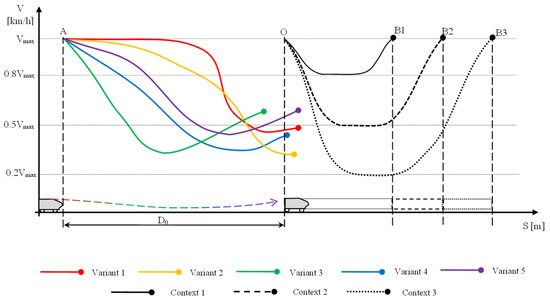
Figure 1.
An overview diagram of the traffic model (source: own development).
The simulation continues from the moment t = 0, when PN is point A, and PP starts braking at point O, until the moment t = T, when PP obtains again the maximum speed—depending on the context of movement—at the points B1, B2, B3.
The “following” train at time t = T has speed V(T) and is at distance S(T) from point A, and at distance D(T) from end point PP.
The parameters of PN, S(T)—the distance traveled, V(T)—the speed of the train, D(T)—the distance to the preceding train, and the mechanical energy used, Z(T), are the key values for evaluating the control variants used.
The possibility of using appropriate speed control PN allows the train speed to be corrected and adjusted in advance, taking into account the changed traffic conditions on the section of the railroad line ahead of this train.
3.3.1. Contexts
The behavior of PP is determined by the traffic situation, as well as the interaction of the traction vehicle’s systems with those of the trackside equipment.
For the purpose of the study, it is necessary to extract a few characteristic situations from the entire area of possible traffic scenarios, which allow the evaluation of solutions in the broadest possible perspective (speed changes PP).
In this work, a disturbance in the movement of PP, of a short-term nature, causes a reduction in the speed of PP; then, with a 10 s time delay for the switching of the braking system to the acceleration system, the recovery of maximum speed is considered. The time T after which the recovery of the maximum speed of PP will occur is the moment of termination of the simulation and depends on the limiting speed PP adopted in the given traffic context: VP = Vogr.
For the three traffic contexts, three speed limits PP were adopted: context 1 Vogr = 160 km/h, context 2 Vogr = 100 km/h, context 3 Vogr = 40 km/h.
- Context 1 represents a speed reduction of 20% of the maximum speed and can refer to situations of temporary signal loss in the ETCS system.
- Context 2 assumes a value of 50% of the maximum speed and may result from the occurrence of a speed restriction based on speed grading in the automatic linear interlocking system.
- Context 3 represents a speed reduction of 80% of the maximum speed and can represent the situation of transition in ETCS between SR and FS modes.
Contexts are also based on the assumption that trains following each other on a section of the railroad line, traveling at maximum speed, are subject to the study: Vmax = 200 km/h. On the other hand, the adopted way of conducting train traffic is not disturbed by predetermined traffic operations, e.g., stopping a passenger train at the platform, passing a train through a group of tracks (turnouts) or changing the order of trains on a section of the railroad line. This is because such traffic situations should be taken into account in the train running plan with an appropriate time reserve, and the adoption of the situation of stopping PP does not allow optimization of the control of PN without knowledge about the required time of stopping PP.
The contexts are based on real operating situations of applied speed restrictions, i.e., speed reduction to 160 km/h when ETCS is switched off and the train is running without system supervision; speed reduction to 100 km/h when a train passes a junction; speed reduction of 40 km/h when ETCS operation is changed from “Full Supervision” to “Staff Responsible”.
As mentioned above, contexts have been assumed as contingencies, with a short-term effect and a temporary reduction in speed. This is because the occurrence of a disruption to PP traffic should generate minimal secondary disruptions to the next train, especially when there are moving block distances between trains and an effort to minimize the distance between them.
3.3.2. Variants
PN control was implemented for 5 variants, where variant 1 is a variant of the current train operation.
The options are based on the possible ways of transmitting and using train and infrastructure information managed in the ERTMS control system.
- Variant 1
In variant 1, the speed of PN is limited by the allowable distance to the end of PP, resulting from the maintenance of a safe stopping distance. In the absence of a speed limit, PN moves or accelerates to the maximum speed: VP = Vmax.
PN control is based on the indications of the control system on the driver’s desktop (in the ETCS-DMI system) and in addition, the driver’s observation of the signaling on the route; the minimum required visibility of semaphore indications from a distance of 500 m has been established.
If the need to reduce speed arises, the driver implements “service” braking with ah = 0.5 m/s2 for the situation of exceeding the safe speed (resulting from the distance between trains) and has “emergency” braking applied with aH = 1.5 m/s2.
The model adopted the following gradations of braking (Table 1):

Table 1.
Graduation of braking force.
The maximum distance between trains when PN variant 1 is forced to implement braking (speed reduction) will be referred to as the limit distance and denoted as Dgr.
- Variant 2
The speed and location (end of train) information PP is sent to PN. Since the information undergoes a delay from the current moment as a result of transmission and processing, the model assumes the use of PP information with a delay of Tsp = 10 s.
PN control is based on the comparison of speeds between trains: when VN > VP, the driver shuts down the drive, and the train moves by momentum, thus reducing traction energy consumption.
If VN ≤ VP, driving at maximum speed continues.
Maintaining a safe distance between trains is implemented as in variant 1, i.e., excessive approach of PN to the end of PP results in the implementation of braking according to the gradation of braking force as in Table 1.
- Variant 3
Information about the speed and location (end of train) of PP (Tsp as in variant 2) is sent to PN.
PN control involves synchronizing the speed between trains, i.e., based on the speed information PP, the required maximum allowable delay or acceleration PN needed to equalize the speed of the two trains is recalculated.
Maintaining a safe distance between trains is implemented as in variant 1, i.e., excessive approach of PN to the end of PP results in the implementation of braking according to the gradation of braking force as in Table 1.
- Variant 4
Information about the speed and location (end of train) of PP (Tsp as in variant 2) is sent to PN.
PN control involves comparing the speed and distance D(t) between the trains. Based on this information, the required maximum permissible delay is recalculated as ah, in order to obtain the speed of the two trains aligned over a certain distance.
For VN > VP, the braking force is calculated from the amount of energy required to change the kinetic energy PN according to the following relation:
In the case of VN ≤ VP, driving at maximum speed continues.
Maintaining a safe distance between trains is implemented as in variant 1, i.e., excessive approach of PN to the end of PP results in the implementation of braking according to the gradation of braking force as in Table 1.
- Variant 5
Information about the speed and location (end of train) of PP (Tsp as in variant 2) is sent to PN.
The control of PN is identical to variant 4, the difference is a different way of determining the braking force, taking into account the resistance to movement.
For VN > VP, the determined path is based on the following relationship:
where mf—rotating mass of the train, VN—speed PN, VP—speed PP, k1—coefficient in the equation of resistance to motion, depending on the square of the speed, k2—coefficient in the equation of resistance to motion, depending on the speed, k3—coefficient in the equation of resistance to motion, independent of speed.
Selection of the best value of ah is made for the criterion: (D − Sh) → 0.
The recalculation of values is repeated at a cycle of Tc = 10 s.
In the case of VN ≤ VP, driving at maximum speed continues.
Maintaining a safe distance between trains is implemented as in variant 1, i.e., excessive approach of PN to the end of PP results in the implementation of braking according to the gradation of braking force as in Table 1.
The comparison of results from each variant refers to the passage of the “reference” train (undisturbed movement of the “following” train), normalizing the parameters of speed loss and travel time extension in each variant (the relationship shown in Section 3.4). The calculated mechanical energy consumption is due to the need to recover the lost speed, distance and time between PN and PW.
3.4. Input Data
The model is based on the characteristics established for the ETR610 type ED250.
The train model was described, with traction characteristics based on the parameters given in the publication [33].
For the acceleration of a train on a straight and level track, with a normal load (weight of 427 tons) and 100% of the available traction power, the following accelerations are used:
- ar = 0.49 m/s2—average acceleration from 0 km/h to 40 km/h,
- ar = 0.49 m/s2—average acceleration from 0 km/h to 120 km/h,
- ar = 0.36 m/s2—average acceleration from 0 km/h to 160 km/h,
- ar = 0.07 m/s2—residual acceleration at 250 km/h.
The traffic resistance was determined based on the parameters specified for the trainsets in the publications [34,35] and is described by the characteristics: F = 8V2 + 130V + 4000 (N) for speeds specified in m/s.
The 187.4-m-long ETR610 train has a weight of 427 tons, converted to a weight that includes rotating components, is 452 tons.
The model assumed the characteristics of the ETR610 train (type ED250) for acceleration from 0 km/h to 200 km/h, braking from 200 km/h to 0 km/h in service mode (−0.5 m/s2) or in emergency mode (−1.5 m/s2), and braking due to the effect of traffic resistance only (section on zero gradient).
The consumption of mechanical energy is calculated as a fractional sum of the energy required to overcome the resistance to movement; if the speed is increased, in addition, the difference in kinetic energy within the limits of the speed change is considered.
For the energy required to overcome the resistance to movement, the drag force was determined for the average speed over a one-second time interval and the distance traveled in that time:
where i is the number of consecutive 1 s time slices such that i: {i = 1, …, Tn}, and Tn is the duration of the analyzed change.
For accelerated motion, the kinetic energy consumption in time T from speed V1 to speed V2 is:
While the total mechanical energy consumption for accelerated motion is:
Below, Figure 2, Figure 3, Figure 4 and Figure 5 show the simulated running of the ETR610 train for the maximum allowable acceleration of the train and different ways of braking from maximum speed to stop.
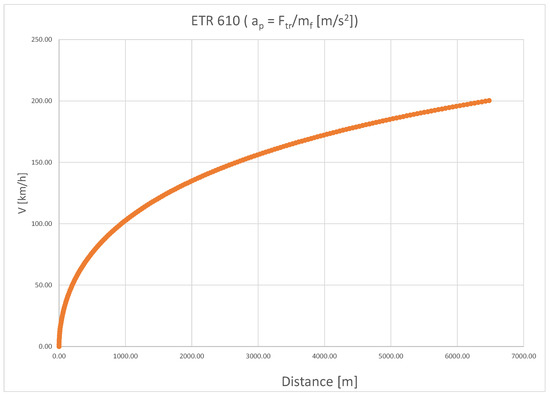
Figure 2.
Acceleration characteristics of the ETR610 (ED250) train.
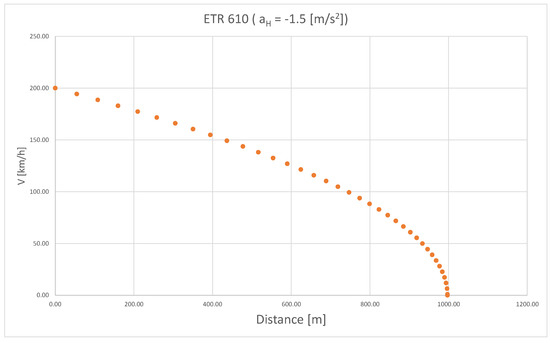
Figure 3.
Emergency braking characteristics of the ETR610 (ED250) train.

Figure 4.
Braking characteristics of the ETR610 (ED250) service train.
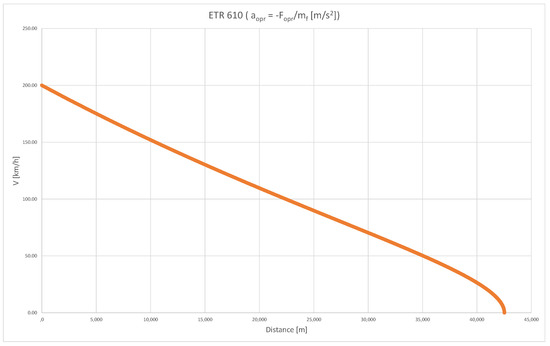
Figure 5.
Braking characteristics due to resistance to motion of the ETR610 (ED250) train.
The presented traction characteristics of acceleration and braking were compared and confirmed with the actual values obtained with an ETR610 train of the ED250 series on railway line No. 9 Warsaw–Gdansk and railway line No. 4 Warsaw–Krakow.
3.5. Verification of Results
Based on the second-by-second changes in speed (acceleration/deceleration) obtained in the simulation, the data and final results were verified in Excel. In one-second successive steps, changes were calculated in distance, speed and mechanical energy consumption. The final results obtained were related to the values obtained in the simulation.
Verification was done for several cases of the obtained runs of PN.
3.6. Results and Their Normalization
The simulation results in different magnitudes of PN traffic parameters, i.e., train speed, distance traveled, and mechanical energy consumed. In order to compare the results obtained for different variants of running PN, normalization was applied, which consists of converting the lost speed, distance and extended running time of PN against PW.
We consider the “reference” train to be the hypothetical movement of the “following” train, without the occurrence of interference and restrictions on the speed of its movement, which will travel from point A to point B during simulation T (Figure 6), using mechanical energy only to overcome the resistance to movement at a constant speed of travel V = Vmax.
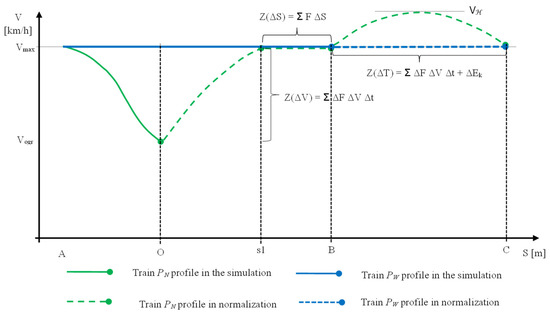
Figure 6.
Normalization of simulation results.
The considered movement PN (Figure 6) from point A to point O travels a route in simulation time T. In contrast, the compared quantities of movement parameters PN are considered at point O.
The standardization process consists of the following:
- Aligning the speed of the “following” train with the “reference” train.
- The required time TO-s1 and mechanical energy Z(∆V) necessary for PN to regain maximum speed V = Vmax (section O–s1 in Figure 6) are determined.
- Alignment of the covered distance of the “following” train with the “model” train.
- The necessary time Ts1–B and the mechanical energy Z(∆S) needed to travel the missing distance to where PW was at time t = T (section s1–B in Figure 6) are determined.
- Elimination of the resulting delay time of the “following” train to the “model” train.
- The mechanical energy Z(∆T) required for the so-called “catch-up” PW (section B–C in Figure 6) is determined, which is possible by hypothetically raising the speed above a fixed maximum speed: > Vmax.
Driving time and mechanical energy consumption PW on section A–B (simulation duration):
Driving time and mechanical energy consumption PW at B–C:
Normalization of driving time and mechanical energy consumption PN from simulation (section A–O):
Normalization of driving time and mechanical energy consumption of the “following” train on the O–s1 section:
where Fopr,v—train speed-dependent drag force; Ftr,v—train speed-dependent traction force.
Normalization of driving time and mechanical energy consumption of the “following” train on the s1–B section:
Normalization of driving time and mechanical energy consumption of the “following” train on section B–C:
where Fh—braking force.
Loss of time:
Loss of mechanical energy:
Algorithm for Converting Time Loss into Mechanical Energy
Assumption: identical acceleration and deceleration PN on B–C: ar = ah = a, PN and PW travel SN = SW = S on B–C with time difference ∆T = Tw − Tn:
because
After transformations, we obtain:
because the change in kinetic energy is equivalent to the action of a force along a given path:
can be written as
After substituting (19) into (17) and transformations, we obtain the dependence of on a, ∆T and Vmax:
The consumption of mechanical energy is determined by the change in kinetic energy of the train and the balancing energy of the drag force. The drag force is averaged for the speed of the arithmetic mean of and Vmax and is assumed to act on half of the section B–C, where traction force is applied to change the speed from Vmax to .
The difference in energy expended by PN and energy expended by PW on the B–C section is a measure of the mechanical energy lost to compensate for the travel time between trains:
4. Simulation Results
4.1. Description
In the simulation, the results of the change in speed and location of PN were obtained for contexts and variants of train running for 135 traffic situations (3 contexts × 5 variants × 9 distances).
In the form of tables and figures, the resultant (final) values for all traffic situations at time t = T (s) concerning the speed obtained by PN: speed, distance traveled and mechanical energy consumed, and calculations from the normalization of the results, allow for a final comparison of the extension of travel time PN and the loss of mechanical energy with respect to the reference train PW.
From the simulations, key movement situations where the case of boundary distance (described in Section 3.3) arises were extracted and are shown in Figure 7, Figure 8, Figure 9, Figure 10, Figure 11 and Figure 12 for each movement context of the relationships: V(t), S(t). In addition, for each context and each initial distance, the relationship D(t) is shown in Figure 13, Figure 14 and Figure 15, where the smallest distance between trains conducive to the use of virtual coupling is sought. For the selected distance, the V(t) relationship is also shown in Figure 16 and Figure 17, which allows us to assess whether the selected train control option also allows for smooth train movement.
The values presented in the following tables (Table 2, Table 3 and Table 4) should be interpreted as follows:

Table 2.
Simulation results for context 1.

Table 3.
Simulation results for context 2.

Table 4.
Simulation results for context 3.
Results obtained in the simulation:
T—simulation time,
S—the distance traveled by PN at time T,
V—speed PN at time t = T,
Zm—consumed mechanical energy by PN at time T.
The results obtained in the normalization process (according to the formulas given in Section 3.1):
Loss S—the difference of the distance traveled PN to PW when PN obtains speed Vmax,
Loss T—the required time PN to equalize the speed to Vmax and get to the place Sw(T), where PW is at t = T
Zm + Comp. S—the difference of the consumed mechanical energy PN to PW (Zm + compensation for the lost path Loss S), calculated from the beginning of the simulation until PN is in place Sw(T)—when PW was at the end of the simulation t = T. In the case where there was a slight reduction in the speed of PN in the simulation (less resistance to movement), a negative value is possible, which indicates that PN moved according to a less energy-intensive characteristic at the expense of increased travel time (Loss T),
Comp. T—the amount of mechanical energy required for PN to offset the lost time to PW,
∑Zm—the difference of consumed mechanical energy PN to PW (Zm + Comp. S), taking into account the compensation of lost time PN (Comp. T), which will allow PN to be in the same place, time and speed as PW.
In the cell, the colors indicate the gradation of values: green least (most favorable)—red most (least favorable).
4.2. Result
From the figures shown in the above tables for total mechanical energy consumption due to changes in speed and loss of distance and increase in travel time PN, one can see how shortening the distance between trains increases energy consumption.
The following boundary distances were determined in the simulation, Context 1—2000 m, Context 2—4000 m, Context 3—5000 m, and represent an important magnitude from the point of view of the possibility of applying PN speed control and optimizing train energy consumption.
For the distance between trains exceeding the limit distance, in terms of energy consumption PN, variant 1 is the most favorable, which is due to the possibility of running the train at maximum speed, while the length of the distance allowed buffering the disruption of the movement speed PP.
For distances between trains smaller than the boundary distance, in terms of energy consumption, variant 5 is then most advantageous, where the train control takes into account the speed PP, the distance between trains, and the resistance of traffic on the distance between trains.
The estimated difference in mechanical energy consumption of variant 1 to the most favorable variant is:
- Context 1, Dgr = 2000 m: w1 − w5 = 12.950, w2 − w5 = 26.827, w3 − w5 = 4.289, w4 − w5 = 0.028 (kWh);
- Context 2, Dgr = 4000 m: w1 − w5 = 39.120, w2 − w5 = 22.625, w3 − w5 = 205.473, w4 − w5 = 106.467 (kWh);
- Context 3, Dgr = 5000 m: w1 − w5 = 105.540, w2 − w5 = 43.178, w3 − w5 = 270.045, w4 − w5 = 129.366 (kWh).
Further shortening the distance between trains to a distance of 1000 m, the difference between the variants of the control disappears, which does not allow us to identify the single most favorable variant: often, variant 4 appears, there are variants 2 and 3, and once there is a variant 1. It is important that for a distance of less than 2000 m (in any context) the idea of control loses its meaning—the curves of running PN for the different variants are close to each other, except for variant 2, the use of which is unfavorable due to a significant increase in the time of running PN.
The following figures show the PN run curves for boundary distances. The dashed curve in black refers to the run shape of the preceding train, which has been shifted to the left in the figures of the V(t) relationship for illustrative purposes, by the boundary distance.
For context 1:
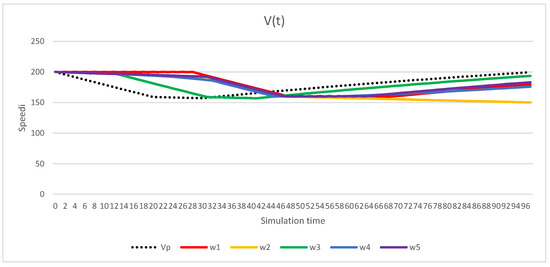
Figure 7.
Velocity change V(t) in simulation by context 1 for distance D0 = Dgr = 2000 m.
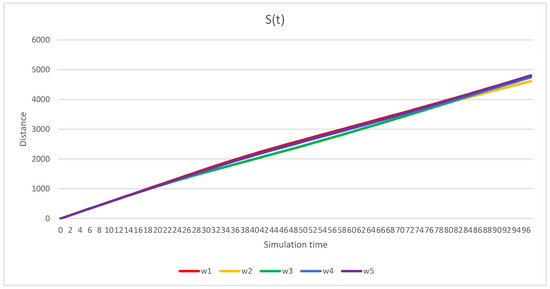
Figure 8.
Change in distance traveled S(t) in simulation by context 1 for distance D0 = Dgr = 2000 m.
For context 2:
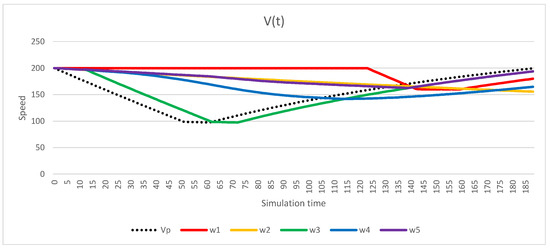
Figure 9.
Velocity change V(t) in simulation by context 2 for distance D0 = Dgr = 4000 m.
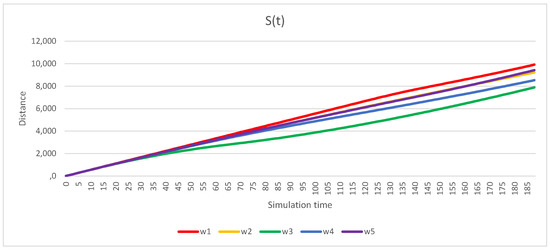
Figure 10.
Change in distance traveled S(t) in simulation by context 2 for distance D0 = Dgr = 4000 m.
For context 3:
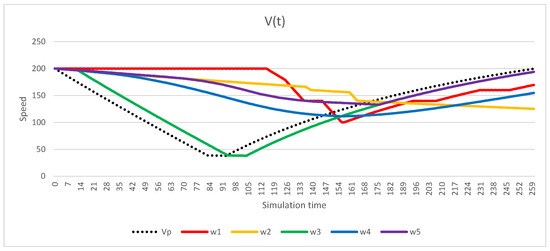
Figure 11.
Velocity change V(t) in simulation by context 3 for distance D0 = Dgr = 5000 m.
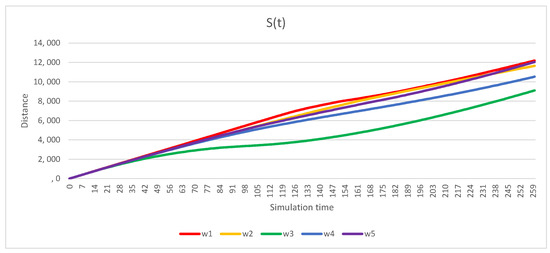
Figure 12.
Change in distance traveled S(t) in simulation by context 3 for distance D0 = Dgr = 5000 m.
In the presented Figure 7, Figure 8, Figure 9, Figure 10, Figure 11 and Figure 12 you can see how the movement of PN is shaped for Variant 5. With respect to other variants, the control in Variant 5 allows, during the whole simulation, obtaining a high train speed (but not too high, causing excessive approach to PP), which allows us to obtain a running distance and small time losses with respect to the “reference” train.
4.3. Results in Terms of Creating a Virtual Coupling
In order to identify the best solution for creating a virtual coupling, the following assumptions were made:
- (1)
- A constant distance D(t) is maintained between PN and PP, which means the speed is equalized between the trains;
- (2)
- The solution is chosen for the shortest distance D0;
- (3)
- The V(t) curve for the PN waveform has a smooth character (small changes in speed), which indicates the smoothness of the PN movement.
Figure 13, Figure 14 and Figure 15 show for each movement context the curves of distance change D(t) train PN, depending on the assumed initial distance: D0 = 5000, 4500, 4000, 3500, 3000, 2500, 2000, 1500, 1000 m.
Changes in the distance between PN and PP over the course of the simulation for context 1:
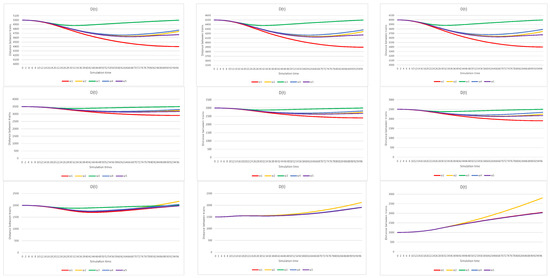
Figure 13.
Summary of distance curves D(t) for D0 = 5000, 4500, 4000, 3500, 3000, 2500, 2000, 1500, 1000 (m) in simulation for context 1.
Changes in the distance between PN and PP over the course of the simulation for context 2:


Figure 14.
Summary of distance curves D(t) for D0 = 5000, 4500, 4000, 3500, 3000, 2500, 2000, 1500, 1000 (m) in simulation for context 2.
Changes in the distance between PN and PP over the course of the simulation for context 3:
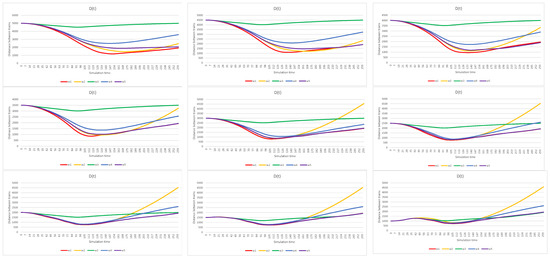
Figure 15.
Summary of distance curves D(t) for D0 = 5000, 4500, 4000, 3500, 3000, 2500, 2000, 1500, 1000 (m) in simulation for context 3.
For context 1, the run PN, which is characterized by maintaining a constant distance in the simulation, occurs only for variant 3 at distances D0 = 3500, 3000, 2500, 2000 m (Figure 13: row 2 and row 3, column 1).
Given the assumption of choosing the shortest distance D0 and keeping a constant distance between trains, the most favorable solution for achieving virtual coupling is to control according to variant 3 at a distance D0 = 2000 m, which is also the limiting distance for this context.
For context 2, the course of PN that is characterized by maintaining a constant distance over the length of the entire simulation, can also be observed only for variant 3 at distances: D0 = 5000, 4500, 4000, 3500, 3000, 2500, 2000 m (Figure 14: row 1, row 2 and row 3, column 1).
Given the assumption of choosing the shortest distance D0 and the smoothness of movement PN based on the V(t) curve (Figure 16), the most favorable solution for achieving virtual coupling is to control according to variant 3 at a distance D0 = 2000 m.
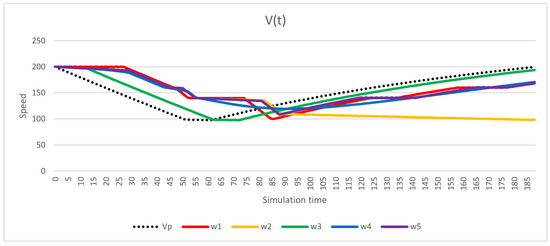
Figure 16.
Velocity change V(t) in simulation by context 2 for distance D0 = 2000 m.
For context 3, the course of PN that is characterized by maintaining a constant distance over the length of the entire simulation can also be observed only for variant 3 at distances: D0 = 5000, 4500, 4000, 3500, 3000, 2500, 2000 m (Figure 14: row 1, row 2 and row 3, column 1).
Given the assumption of choosing the shortest distance D0 and the smoothness of movement PN based on the V(t) curve (Figure 17), the most favorable solution for achieving virtual coupling is to control according to variant 3 at a distance D0 = 2000 m.
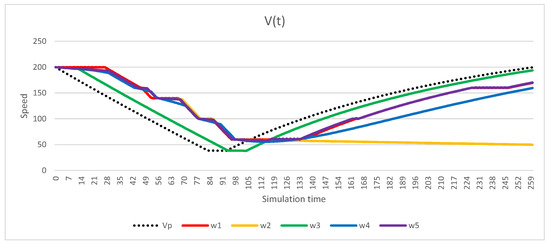
Figure 17.
Velocity change V(t) in simulation by context 3 for distance D0 = 2000 m.
From the above comparisons, it can be seen that for each context, the best solution for creating a virtual coupling is variant 3 with a distance between trains of 2000 m.
However, the use of this option carries the choice of a more energy-intensive solution:
- For context 1, the difference in energy consumption is: w3 − w2 = 4289 kWh,
- For context 2: w3 − w4 = 25,676 kWh,
- For context 3: w3 − w5 = 0.878 kWh,
Which, however, is not a significant figure, considering that it represents less than 10% of the energy lost.
4.4. Sensitivity Analysis
A sensitivity analysis was performed to assess the impact of different contexts on the presented parameters for the evaluation of the options (Table 5).

Table 5.
Sensitivity analysis of the impact on performance of the different contexts.
The reference values are the running parameters of a reference train (undisturbed) moving at maximum speed during the realized simulation, consuming the specified mechanical energy over the distance travelled.
The values were related to the running of a PN train running according to variant 5, for an initial distance of 4 km and a distance of 2 km (Table 2, Table 3 and Table 4).
The analysis carried out shows the following relationships:
- The magnitude of the speed reduction of the PP train with respect to the PN parameters is non-linear. The difference in speed and distance loss between contexts 1 and 2 is smaller than between contexts 2 and 3.
- The factor most susceptible to context variation is the path loss (speeds stabilize at 85%), which has a key impact on the final value of time loss and ultimately on energy consumption.
- Reducing the initial distance affects energy consumption more than the context change itself. This can be seen by comparing the percentage of energy consumption for context 3 at D0 = 4 km compared to contexts 1 and 2, at D0 = 2 km. A factor contributing to this condition is the lack of smoothness of the train (dynamic speed changes).
5. Conclusions and Discussion
The results obtained in the simulation confirm the possibility of increasing the energy efficiency of the train by using information about the “preceding” train.
The amount of energy consumption of the “following” train is not only influenced by the traffic context of the “preceding” train (the amount of speed reduction), but the distance between the trains is also key.
In the simulation, a boundary distance was established for each traffic context, for which it is reasonable to control the “following” train. This justification is based on obtaining the shortest increase in train travel time, the longest running distance and the highest speed at the end of the interference from the “preceding” train.
Using the normalization of the results (Section 3.6), the obtained values from the simulation for each variant of the “following” train movement can be converted into a single comparative parameter—mechanical energy consumption. For the indicated boundary distances, the most favorable results, related to minimizing the loss of mechanical energy, are obtained for variant 5. In this variant, the mechanical energy consumption with respect to variant 1 is as follows:
- Context 1: ∆Zm (w1 − w5) = 12.950 kWh;
- Context 2: ∆Zm (w1 − w5) = 39.120 kWh;
- Context 3: ∆Zm (w1 − w5) = 105.540 kWh.
The control of PN in variant 5 consists of comparing the speed and distance between trains, taking into account traffic resistance, and based on this, calculating the required maximum permissible delay ah so as to achieve an alignment of the speeds of PN and PP over the indicated distance. However, the application of this option may be problematic due to the need to determine the traffic resistance to which PN will be subjected over the distance approaching PP.
On the basis of the sensitivity analysis carried out, it was also observed that the excessive reduction in the distance between trains is more important for the energy efficiency of the train than the magnitude of the speed reduction in individual contexts. For such cases, the loss of distance has less impact, while the dynamic change in speed of the “following” train is important.
From the point of view of the implementation of virtual coupling, the most advantageous is variant 3 applied at a distance of 2000 m (regardless of the context). Control according to this variant allows you to guide PN using information about the speed of PP. As a result of adjusting the acceleration and braking of the train, it is possible to maintain a constant distance between trains and the smoothness of the movement of the train, which is important for the coupling time of trains.
Further studies should take into account the impact on the control of external conditions, i.e., lowering the power in the overhead line, increasing the resistance of traffic to the incline of the track or changes in the operating conditions of equipment and control systems, such as changes in the time of transmission and processing of information. Such an analysis will make it possible to determine the susceptibility of individual control variants to external factors and to select the most favorable variant for synchronizing train speeds.
Author Contributions
Conceptualization J.S. and A.K.; methodology, J.S.; validation, J.S and A.K.; resources, A.K.; writing—original draft preparation, J.S. and A.K.; visualization, J.S. and A.K.; supervision, J.S. and A.K.; project administration, A.K.; funding acquisition, A.K. All authors have read and agreed to the published version of the manuscript.
Funding
Research was funded by Warsaw University of Technology within the Excellence Initiative: Research University (IDUB) program.
Data Availability Statement
Not applicable.
Conflicts of Interest
The authors declare no conflict of interest.
References
- European Railway Agency. Unisig SUBSET-026 System Requirements Specification; Issue 3.6.0; European Railway Agency: Valenciennes, France, 2016.
- Wontorski, P.; Kochan, A. Komputerowe Systemy Kierowania i Sterowania Ruchem Kolejowym. Część 1: Funkcje, Elementy i Układy (Computer Systems for Directing and Controlling Railway Traffic. Part 1: Functions, Elements and Layouts); OWPW: Warszawa, Poland, 2020. [Google Scholar]
- Koper, E.; Kochan, A.; Gruba, Ł. Simulation of the Effect of Selected National Values on the Braking Curves of an ETCS Vehicle. In Development of Transport by Telematics; Mikulski, J., Ed.; Springer: Cham, Switzerland, 2019; pp. 17–31. [Google Scholar] [CrossRef]
- Mitchell, I.; Goddard, E.; Montes, F.; Stanley, P.; Muttram, R.; Coenraad, W.; Poré, J.; Andrews, S.; Lochman, L. Ertms Level 4, Train Convoys or Virtual Coupling; IRSE International Technical Committee; IRSE: London, UK, 2016. [Google Scholar]
- Quaglietta, E. Analysis of Platooning Train Operations under V2V communication-based signalling: Fundamental modelling and capacity impacts of Virtual Coupling. In Proceedings of the 98th Transportation Research Board Annual Meeting, Washington, DC, USA, 13–17 January 2019. [Google Scholar]
- Flammini, F.; Marrone, S.; Nardone, R.; Petrillo, A.; Santini, S.; Vittorini, V. Towards Railway Virtual Coupling. In Proceedings of the 2018 IEEE International Conference on Electrical Systems for Aircraft, Railway, Ship Propulsion and Road Vehicles & International Transportation Electrification Conference (ESARS-ITEC), Nottingham, UK, 7–9 November 2018. [Google Scholar]
- Niing, Z.; Ou, D.; Zhang, L. Virtual Coupling Formation Scheduling Method for Y-type Rail Transit Lines. In Proceedings of the 2022 IEEE 25th International Conference on Intelligent Transportation Systems (ITSC), Macau, China, 8–12 October 2022; pp. 3673–3678. [Google Scholar] [CrossRef]
- Wang, Q.; Chai, M.; Wang, H.; Zhang, H.; Chai, J.; Lin, B. Cloud-Based Simulated Automated Testing Platform for Virtual Coupling System. In Proceedings of the 2022 IEEE 25th International Conference on Intelligent Transportation Systems (ITSC), Macau, China, 8–12 October 2022; pp. 2738–2743. [Google Scholar] [CrossRef]
- Bin, Z.; Shijun, Y.; Lanfang, Z.; Daming, L.; Yalan, C. Energy-Efficient Speed Profile Optimization for High-Speed Railway Considering Neutral Sections. IEEE Access 2021, 9, 25090–25100. [Google Scholar] [CrossRef]
- ShangGuan, W.; Yan, X.-H.; Cai, B.-G.; Wang, J. Multiobjective optimization for train speed trajectory in CTCS high-speed railway with hybrid evolutionary algorithm. IEEE Trans. Intell. Transp. Syst. 2015, 16, 2215–2225. [Google Scholar] [CrossRef]
- Koper, E.; Kochan, A. Testing the Smooth Driving of a Train Using a Neural Network. Sustainability 2020, 12, 4622. [Google Scholar] [CrossRef]
- Wang, X.; Tang, T.; Su, S.; Yin, J.; Gao, Z.; Lv, N. An integrated energy-efficient train operation approach based on the space-time-speed network methodology. Transp. Res. Part E Logist. Transp. Rev. 2021, 150, 102323. [Google Scholar] [CrossRef]
- Wang, Y.; Zhu, S.; D’Ariano, A.; Yin, J.; Miao, J.; Meng, L. Energy-efficient timetabling and rolling stock circulation planning based on automatic train operation levels for metro lines. Transp. Res. Part C Emerg. Technol. 2021, 129, 103209. [Google Scholar] [CrossRef]
- Zhu, Q.; Su, S.; Tang, T.; Liu, W.; Zhang, Z.; Tian, Q. An eco-driving algorithm for trains through distributing energy: A Q-Learning approach. ISA Trans. 2022, 122, 24–37. [Google Scholar] [CrossRef] [PubMed]
- Houshmand, A.; Cassandras, C.G.; Zhou, N.; Hashemi, N.; Li, B.; Peng, H. Combined Eco-Routing and Power-Train Control of Plug-In Hybrid Electric Vehicles in Transportation Networks. IEEE Trans. Intell. Transp. Syst. 2022, 23, 11287–11300. [Google Scholar] [CrossRef]
- Ying, P.; Zeng, X.; Shen, T.; Wang, Y.; Ma, Z.; Wu, Y. Partial Train Speed Trajectory Optimization. In Proceedings of the 2022 IEEE 25th International Conference on Intelligent Transportation Systems (ITSC), Macau, China, 8–12 October 2022; pp. 548–553. [Google Scholar] [CrossRef]
- Fernández-Rodríguez, A.; Fernández-Cardador, A.; Cucala, A.P. Real time eco-driving of high speed trains by simulation-based dynamic multi-objective optimization. Simul. Model. Pract. Theory 2018, 84, 50–68. [Google Scholar] [CrossRef]
- Xu, B.; Lu, S.; Xue, F.; Jiang, L.; Chen, M. Adaptive Eco-Driving Strategy and Feasibility Analysis for Electric Trains with Onboard Energy Storage Devices. IEEE Trans. Transp. Electrif. 2021, 7, 1834–1848. [Google Scholar] [CrossRef]
- Fernández-Rodríguez, A.; Fernández-Cardador, A.; Cucala, A.P. Balancing energy consumption and risk of delay in high speed trains: A three-objective real-time eco-driving algorithm with fuzzy parameters. Transp. Res. Part C Emerg. Technol. 2018, 95, 652–678. [Google Scholar] [CrossRef]
- Fernández-Rodríguez, A.; Fernández-Cardador, A.; Cucala, A.P. Algorithm for Interoperable Automatic Train Operation. Appl. Sci. 2020, 10, 7705. [Google Scholar] [CrossRef]
- Mensing, F.; Trigui, R.; Bideaux, E. Vehicle trajectory optimization for application in ECO-driving. In Proceedings of the 2011 IEEE Vehicle Power and Propulsion Conference, Chicago, IL, USA, 6–9 September 2011; pp. 1–6. [Google Scholar] [CrossRef]
- Dib, W.; Chasse, A.; Moulin, P.; Sciarretta, A.; Corde, G. Optimal energy management for an electric vehicle in eco-driving applications. Control Eng. Pract. 2014, 29, 299–307. [Google Scholar] [CrossRef]
- Deng, K.; Fang, T.; Feng, H.; Peng, H.; Löwenstein, L.; Hameyer, K. Hierarchical eco-driving and energy management control for hydrogen powered hybrid trains. Energy Convers. Manag. 2022, 264, 115735. [Google Scholar] [CrossRef]
- Kochan, A. Digital Twin Concept of the ETCS application. WUT J. Transp. Eng. 2021, 131, 87–98. [Google Scholar] [CrossRef]
- Koper-Olecka, E.; Kochan, A. APM transport system concept for CPK terminals. WUT J. Transp. Eng. 2020, 130, 29–42. [Google Scholar] [CrossRef]
- Kochan, A.; Gruba, Ł. Analysis of the Migration Process in the ERTMS System from GSM Technology to LTE on the Polish Railway. In Management Perspective for Transport Telematics; Mikulski, J., Ed.; Springer: Cham, Switzerland, 2018; pp. 249–262. [Google Scholar] [CrossRef]
- Kochan, A.; Koper, E. Mathematical Model of the Movement Authority in the ERTMS/ETCS System. In Research Methods and Solutions to Current Transport Problems; Siergiejczyk, M., Krzykowska, K., Eds.; Springer: Cham, Switzerland, 2020; pp. 215–224. [Google Scholar] [CrossRef]
- Panou, K.; Tzieropoulos, P.; Emery, D. Railway Driver Advisory Systems: Evaluation of Methods, Tools and Systems. In Proceedings of the 3th WCTR, Rio de Janeiro, Brazil, 15–18 July 2013. [Google Scholar]
- Szkopiński, J.; Kochan, A. Energy Efficiency and Smooth Running of a Train on the Route While Approaching Another Train. Energies 2021, 14, 7593. [Google Scholar] [CrossRef]
- EN 14531-1:2015; Railway Applications—Methods for Calculation of Stopping and Slowing Distances and Immobilization Braking—Part 1: General Algorithms Utilizing Mean Value Calculation for Train Sets or Single Vehicles. European Standard: Brussels, Belgium, 2015.
- Shift2Rail. X2Rail-1. Start-Up Activites for Advanced Signalling and Automatition Systems. Deliverable D5.1 Moving Block System Specification. 19 July 2019. Available online: https://projects.shift2rail.org (accessed on 19 April 2022).
- SCILAB. Available online: https://www.scilab.org (accessed on 1 July 2022).
- Wawrzyniak, A. Elektryczne Pociągi Zespołowe ETR610 Serii ED250 dla PKP INTERCITY S.A.(ETR610 Electric Trainsets of the ED250 Series for PKP Intercity S.A.); Technika Transportu Szynowego: Radom, Poland, 2013. [Google Scholar]
- Durzyński, Z.; Łastowski, M. Energochłonność Pociągów Zespołowych na Duże Prędkości (Energy Consumption of High-Speed Trains); Pojazdy Szynowe: Poznań, Poland, 2010. [Google Scholar]
- Biliński, J.; Błażejewski, M.; Malczewska, M.; Szczepiórkowska, M. Opory Ruchu Pojazdów Trakcyjnych (Motion Resistance of Traction Vehicles); Technika Transportu Szynowego: Radom, Poland, 2019. [Google Scholar]
Disclaimer/Publisher’s Note: The statements, opinions and data contained in all publications are solely those of the individual author(s) and contributor(s) and not of MDPI and/or the editor(s). MDPI and/or the editor(s) disclaim responsibility for any injury to people or property resulting from any ideas, methods, instructions or products referred to in the content. |
© 2023 by the authors. Licensee MDPI, Basel, Switzerland. This article is an open access article distributed under the terms and conditions of the Creative Commons Attribution (CC BY) license (https://creativecommons.org/licenses/by/4.0/).